Australia's Electric Car Market: Demand, Supply, and Government Policy
VerifiedAdded on 2023/06/07
|9
|1805
|184
Essay
AI Summary
This essay provides an economic analysis of the electric car market in Australia, examining the interplay of demand and supply forces. It considers the impact of factors such as the price of electric cars, unleaded fuel, and electric vehicle charging on the demand for electric cars. The analysis reveals that the demand for electric cars is highly price elastic, making it responsive to price changes. The essay also explores the potential impact of government policies, such as subsidies and incentives, on increasing the supply and reducing the price of electric cars, thereby boosting demand. The study concludes that strategic government interventions can significantly promote the adoption of electric vehicles in Australia.
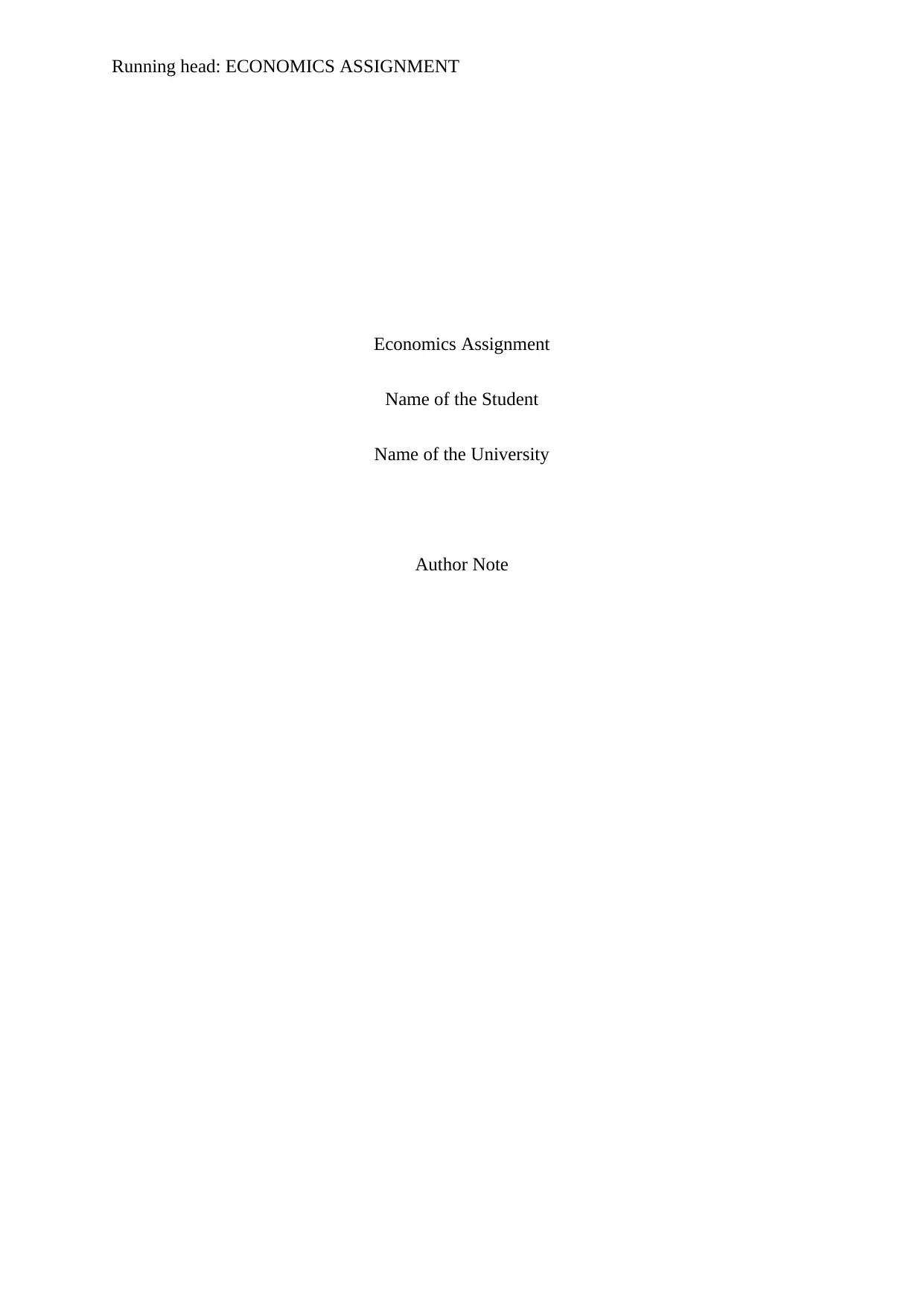
Running head: ECONOMICS ASSIGNMENT
Economics Assignment
Name of the Student
Name of the University
Author Note
Economics Assignment
Name of the Student
Name of the University
Author Note
Paraphrase This Document
Need a fresh take? Get an instant paraphrase of this document with our AI Paraphraser
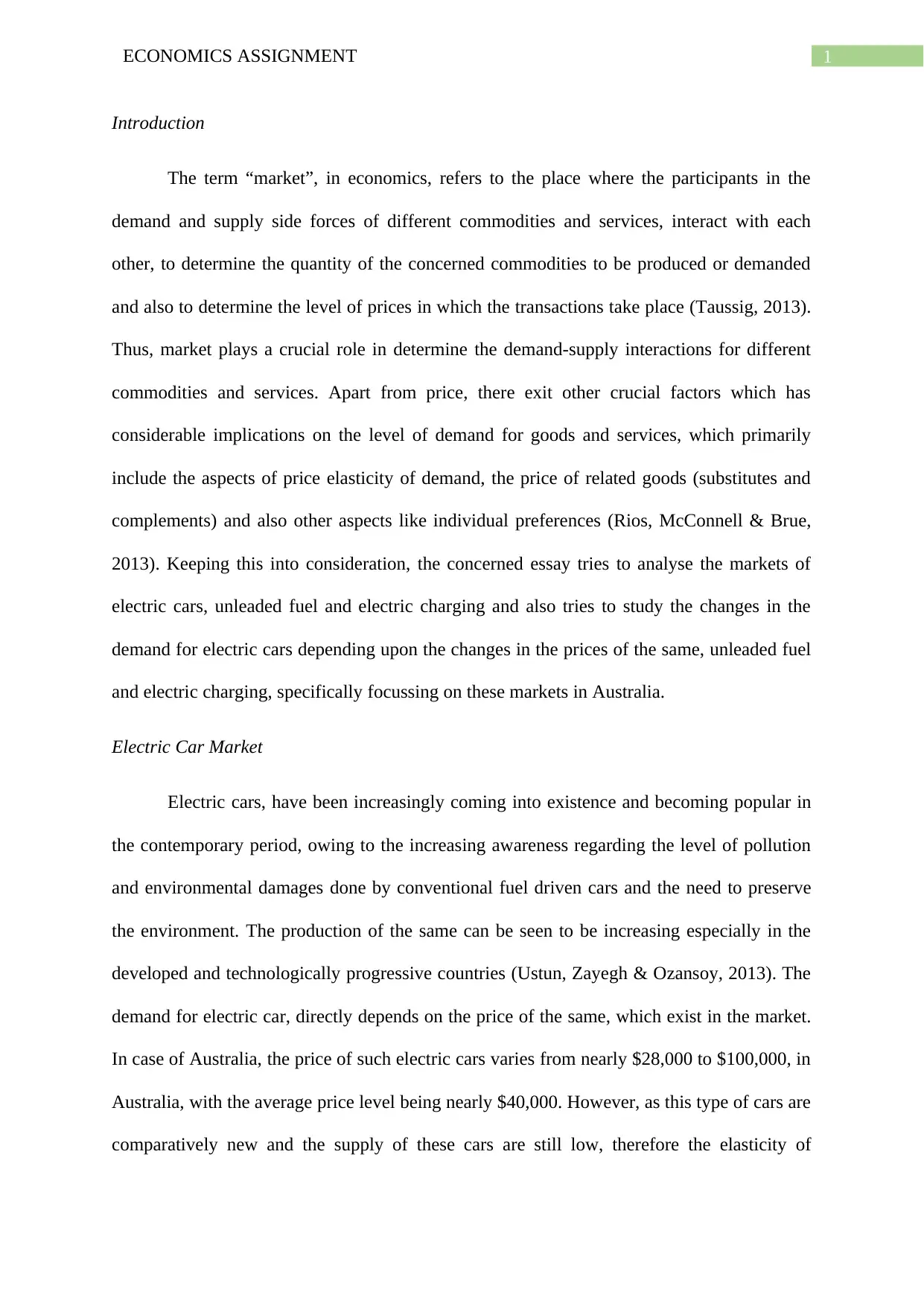
1ECONOMICS ASSIGNMENT
Introduction
The term “market”, in economics, refers to the place where the participants in the
demand and supply side forces of different commodities and services, interact with each
other, to determine the quantity of the concerned commodities to be produced or demanded
and also to determine the level of prices in which the transactions take place (Taussig, 2013).
Thus, market plays a crucial role in determine the demand-supply interactions for different
commodities and services. Apart from price, there exit other crucial factors which has
considerable implications on the level of demand for goods and services, which primarily
include the aspects of price elasticity of demand, the price of related goods (substitutes and
complements) and also other aspects like individual preferences (Rios, McConnell & Brue,
2013). Keeping this into consideration, the concerned essay tries to analyse the markets of
electric cars, unleaded fuel and electric charging and also tries to study the changes in the
demand for electric cars depending upon the changes in the prices of the same, unleaded fuel
and electric charging, specifically focussing on these markets in Australia.
Electric Car Market
Electric cars, have been increasingly coming into existence and becoming popular in
the contemporary period, owing to the increasing awareness regarding the level of pollution
and environmental damages done by conventional fuel driven cars and the need to preserve
the environment. The production of the same can be seen to be increasing especially in the
developed and technologically progressive countries (Ustun, Zayegh & Ozansoy, 2013). The
demand for electric car, directly depends on the price of the same, which exist in the market.
In case of Australia, the price of such electric cars varies from nearly $28,000 to $100,000, in
Australia, with the average price level being nearly $40,000. However, as this type of cars are
comparatively new and the supply of these cars are still low, therefore the elasticity of
Introduction
The term “market”, in economics, refers to the place where the participants in the
demand and supply side forces of different commodities and services, interact with each
other, to determine the quantity of the concerned commodities to be produced or demanded
and also to determine the level of prices in which the transactions take place (Taussig, 2013).
Thus, market plays a crucial role in determine the demand-supply interactions for different
commodities and services. Apart from price, there exit other crucial factors which has
considerable implications on the level of demand for goods and services, which primarily
include the aspects of price elasticity of demand, the price of related goods (substitutes and
complements) and also other aspects like individual preferences (Rios, McConnell & Brue,
2013). Keeping this into consideration, the concerned essay tries to analyse the markets of
electric cars, unleaded fuel and electric charging and also tries to study the changes in the
demand for electric cars depending upon the changes in the prices of the same, unleaded fuel
and electric charging, specifically focussing on these markets in Australia.
Electric Car Market
Electric cars, have been increasingly coming into existence and becoming popular in
the contemporary period, owing to the increasing awareness regarding the level of pollution
and environmental damages done by conventional fuel driven cars and the need to preserve
the environment. The production of the same can be seen to be increasing especially in the
developed and technologically progressive countries (Ustun, Zayegh & Ozansoy, 2013). The
demand for electric car, directly depends on the price of the same, which exist in the market.
In case of Australia, the price of such electric cars varies from nearly $28,000 to $100,000, in
Australia, with the average price level being nearly $40,000. However, as this type of cars are
comparatively new and the supply of these cars are still low, therefore the elasticity of
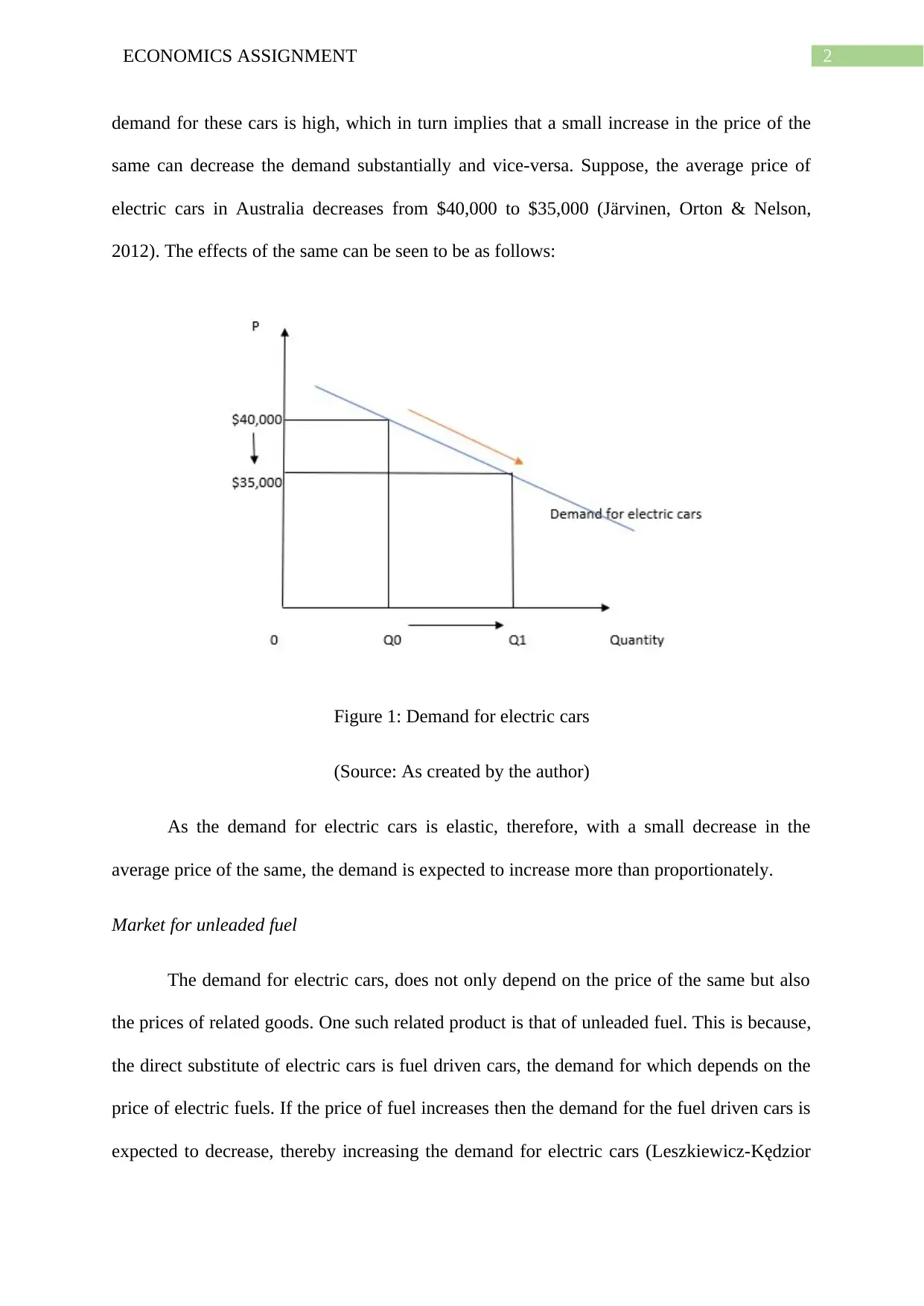
2ECONOMICS ASSIGNMENT
demand for these cars is high, which in turn implies that a small increase in the price of the
same can decrease the demand substantially and vice-versa. Suppose, the average price of
electric cars in Australia decreases from $40,000 to $35,000 (Järvinen, Orton & Nelson,
2012). The effects of the same can be seen to be as follows:
Figure 1: Demand for electric cars
(Source: As created by the author)
As the demand for electric cars is elastic, therefore, with a small decrease in the
average price of the same, the demand is expected to increase more than proportionately.
Market for unleaded fuel
The demand for electric cars, does not only depend on the price of the same but also
the prices of related goods. One such related product is that of unleaded fuel. This is because,
the direct substitute of electric cars is fuel driven cars, the demand for which depends on the
price of electric fuels. If the price of fuel increases then the demand for the fuel driven cars is
expected to decrease, thereby increasing the demand for electric cars (Leszkiewicz-Kędzior
demand for these cars is high, which in turn implies that a small increase in the price of the
same can decrease the demand substantially and vice-versa. Suppose, the average price of
electric cars in Australia decreases from $40,000 to $35,000 (Järvinen, Orton & Nelson,
2012). The effects of the same can be seen to be as follows:
Figure 1: Demand for electric cars
(Source: As created by the author)
As the demand for electric cars is elastic, therefore, with a small decrease in the
average price of the same, the demand is expected to increase more than proportionately.
Market for unleaded fuel
The demand for electric cars, does not only depend on the price of the same but also
the prices of related goods. One such related product is that of unleaded fuel. This is because,
the direct substitute of electric cars is fuel driven cars, the demand for which depends on the
price of electric fuels. If the price of fuel increases then the demand for the fuel driven cars is
expected to decrease, thereby increasing the demand for electric cars (Leszkiewicz-Kędzior
⊘ This is a preview!⊘
Do you want full access?
Subscribe today to unlock all pages.

Trusted by 1+ million students worldwide
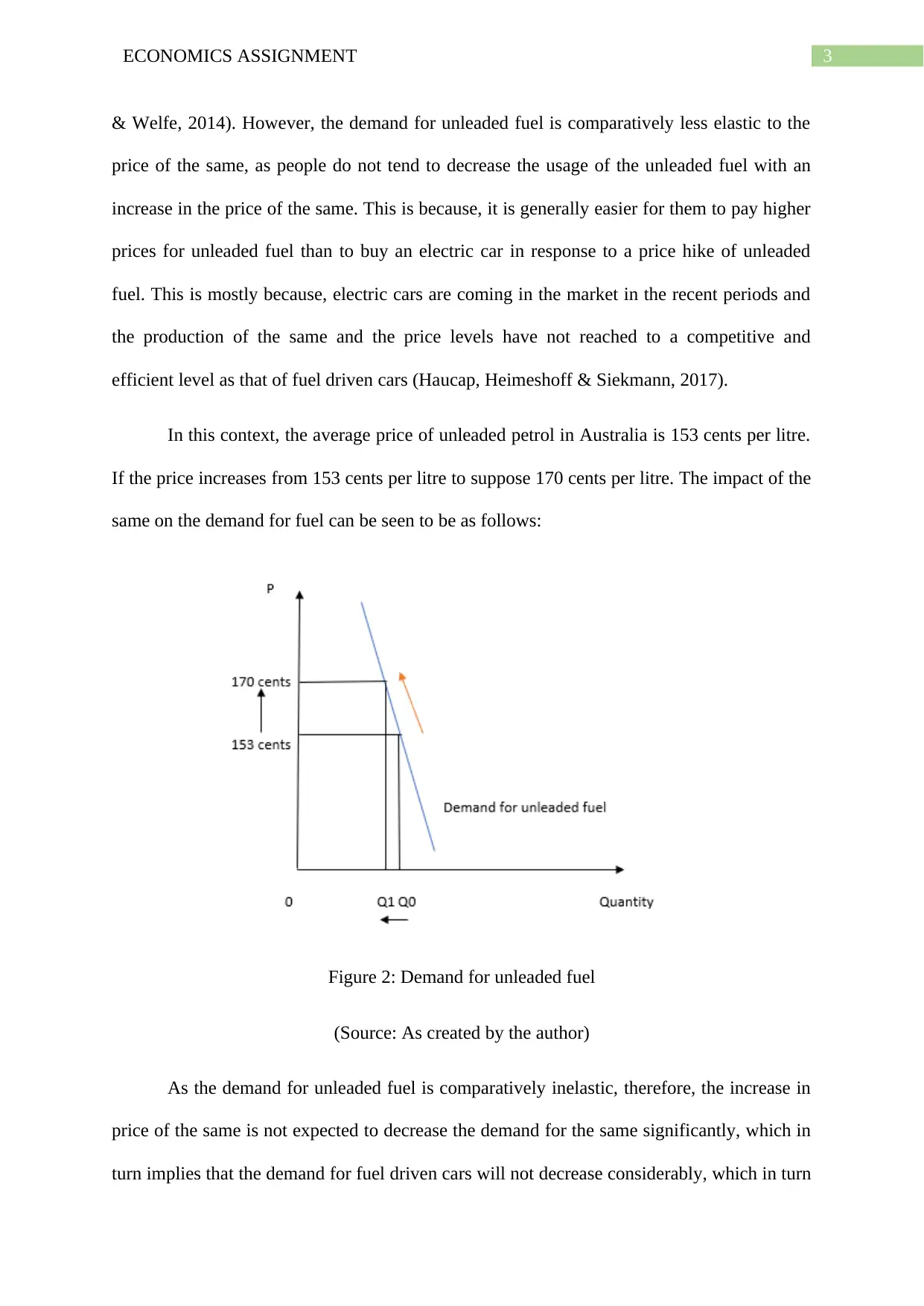
3ECONOMICS ASSIGNMENT
& Welfe, 2014). However, the demand for unleaded fuel is comparatively less elastic to the
price of the same, as people do not tend to decrease the usage of the unleaded fuel with an
increase in the price of the same. This is because, it is generally easier for them to pay higher
prices for unleaded fuel than to buy an electric car in response to a price hike of unleaded
fuel. This is mostly because, electric cars are coming in the market in the recent periods and
the production of the same and the price levels have not reached to a competitive and
efficient level as that of fuel driven cars (Haucap, Heimeshoff & Siekmann, 2017).
In this context, the average price of unleaded petrol in Australia is 153 cents per litre.
If the price increases from 153 cents per litre to suppose 170 cents per litre. The impact of the
same on the demand for fuel can be seen to be as follows:
Figure 2: Demand for unleaded fuel
(Source: As created by the author)
As the demand for unleaded fuel is comparatively inelastic, therefore, the increase in
price of the same is not expected to decrease the demand for the same significantly, which in
turn implies that the demand for fuel driven cars will not decrease considerably, which in turn
& Welfe, 2014). However, the demand for unleaded fuel is comparatively less elastic to the
price of the same, as people do not tend to decrease the usage of the unleaded fuel with an
increase in the price of the same. This is because, it is generally easier for them to pay higher
prices for unleaded fuel than to buy an electric car in response to a price hike of unleaded
fuel. This is mostly because, electric cars are coming in the market in the recent periods and
the production of the same and the price levels have not reached to a competitive and
efficient level as that of fuel driven cars (Haucap, Heimeshoff & Siekmann, 2017).
In this context, the average price of unleaded petrol in Australia is 153 cents per litre.
If the price increases from 153 cents per litre to suppose 170 cents per litre. The impact of the
same on the demand for fuel can be seen to be as follows:
Figure 2: Demand for unleaded fuel
(Source: As created by the author)
As the demand for unleaded fuel is comparatively inelastic, therefore, the increase in
price of the same is not expected to decrease the demand for the same significantly, which in
turn implies that the demand for fuel driven cars will not decrease considerably, which in turn
Paraphrase This Document
Need a fresh take? Get an instant paraphrase of this document with our AI Paraphraser
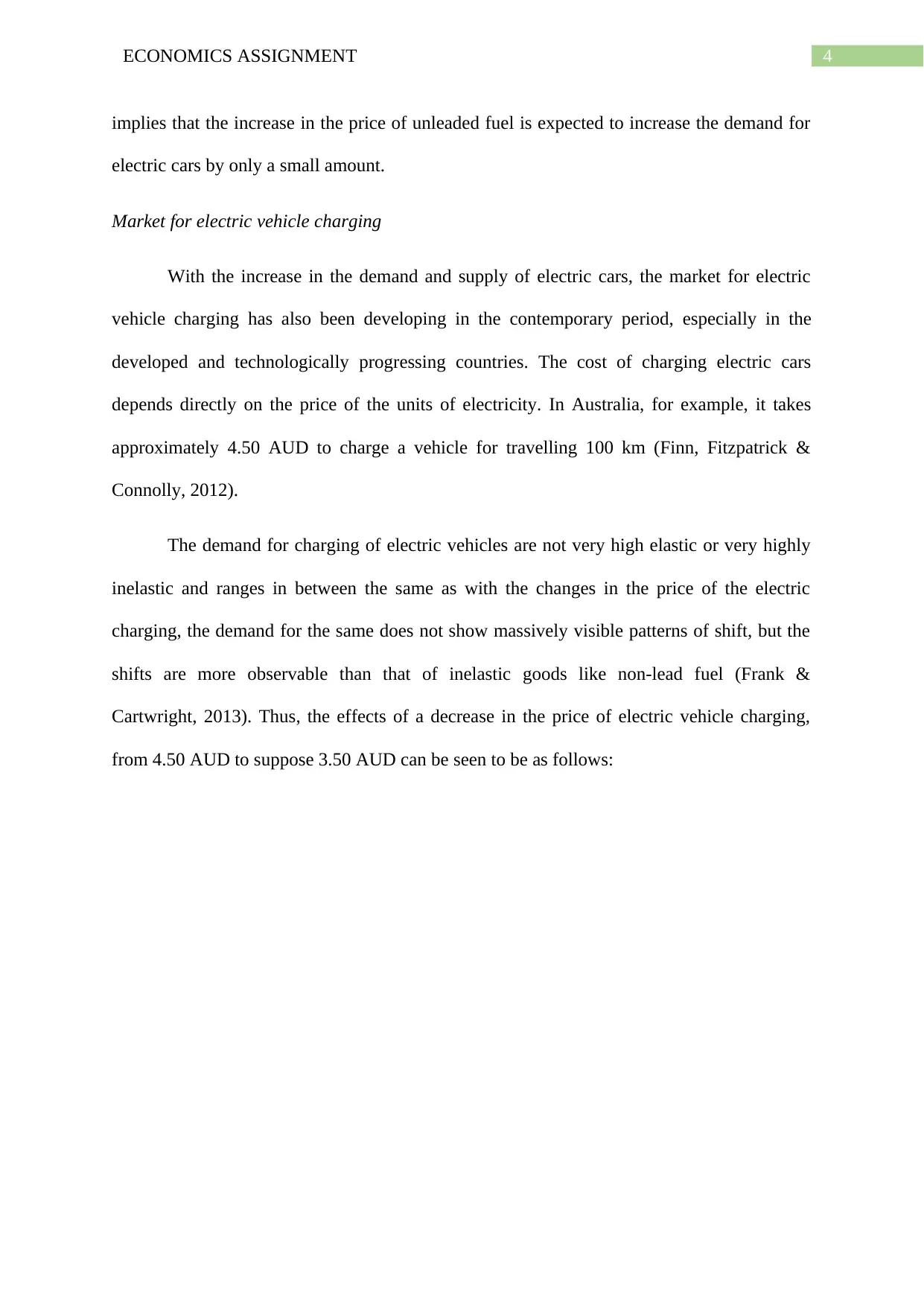
4ECONOMICS ASSIGNMENT
implies that the increase in the price of unleaded fuel is expected to increase the demand for
electric cars by only a small amount.
Market for electric vehicle charging
With the increase in the demand and supply of electric cars, the market for electric
vehicle charging has also been developing in the contemporary period, especially in the
developed and technologically progressing countries. The cost of charging electric cars
depends directly on the price of the units of electricity. In Australia, for example, it takes
approximately 4.50 AUD to charge a vehicle for travelling 100 km (Finn, Fitzpatrick &
Connolly, 2012).
The demand for charging of electric vehicles are not very high elastic or very highly
inelastic and ranges in between the same as with the changes in the price of the electric
charging, the demand for the same does not show massively visible patterns of shift, but the
shifts are more observable than that of inelastic goods like non-lead fuel (Frank &
Cartwright, 2013). Thus, the effects of a decrease in the price of electric vehicle charging,
from 4.50 AUD to suppose 3.50 AUD can be seen to be as follows:
implies that the increase in the price of unleaded fuel is expected to increase the demand for
electric cars by only a small amount.
Market for electric vehicle charging
With the increase in the demand and supply of electric cars, the market for electric
vehicle charging has also been developing in the contemporary period, especially in the
developed and technologically progressing countries. The cost of charging electric cars
depends directly on the price of the units of electricity. In Australia, for example, it takes
approximately 4.50 AUD to charge a vehicle for travelling 100 km (Finn, Fitzpatrick &
Connolly, 2012).
The demand for charging of electric vehicles are not very high elastic or very highly
inelastic and ranges in between the same as with the changes in the price of the electric
charging, the demand for the same does not show massively visible patterns of shift, but the
shifts are more observable than that of inelastic goods like non-lead fuel (Frank &
Cartwright, 2013). Thus, the effects of a decrease in the price of electric vehicle charging,
from 4.50 AUD to suppose 3.50 AUD can be seen to be as follows:
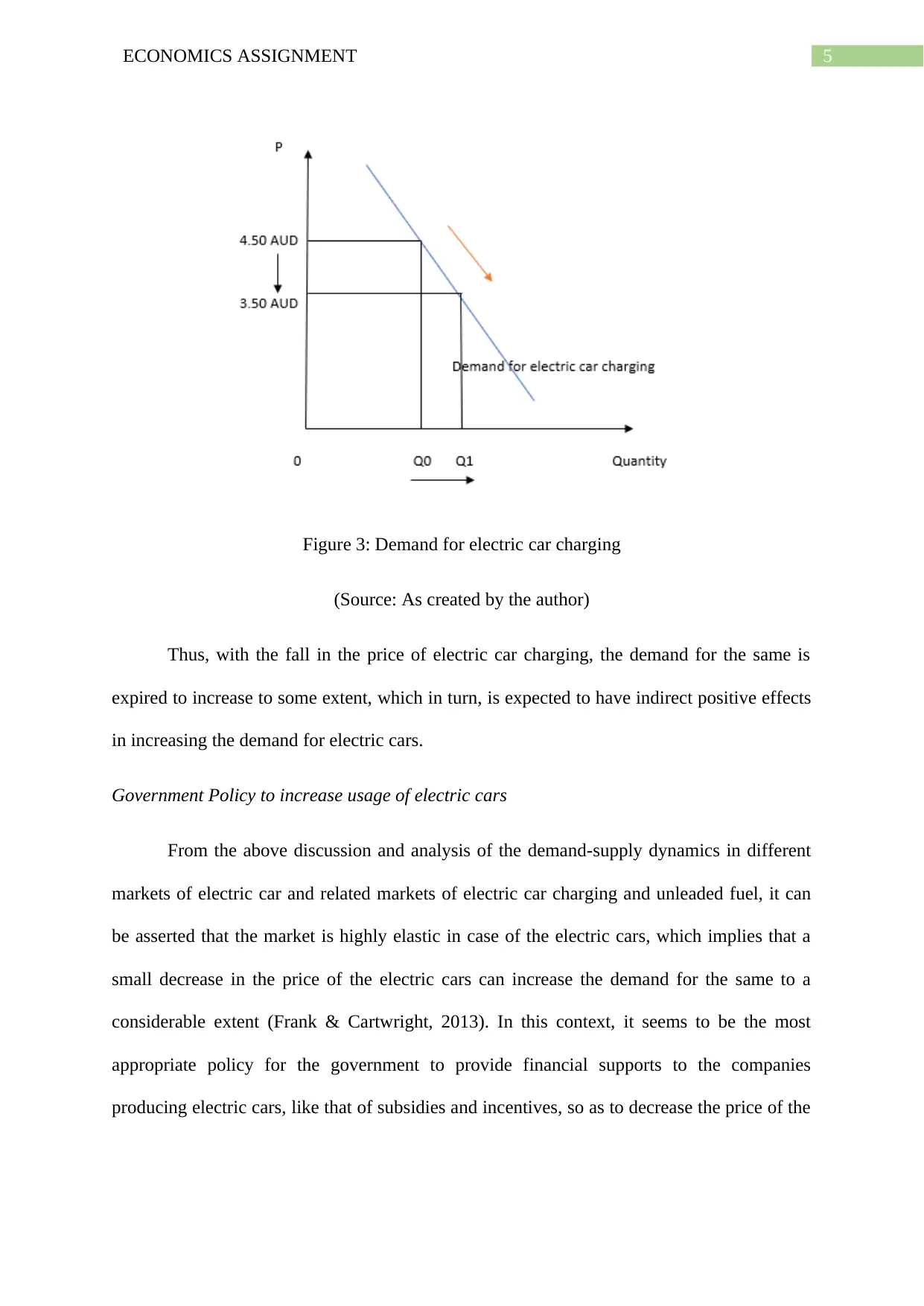
5ECONOMICS ASSIGNMENT
Figure 3: Demand for electric car charging
(Source: As created by the author)
Thus, with the fall in the price of electric car charging, the demand for the same is
expired to increase to some extent, which in turn, is expected to have indirect positive effects
in increasing the demand for electric cars.
Government Policy to increase usage of electric cars
From the above discussion and analysis of the demand-supply dynamics in different
markets of electric car and related markets of electric car charging and unleaded fuel, it can
be asserted that the market is highly elastic in case of the electric cars, which implies that a
small decrease in the price of the electric cars can increase the demand for the same to a
considerable extent (Frank & Cartwright, 2013). In this context, it seems to be the most
appropriate policy for the government to provide financial supports to the companies
producing electric cars, like that of subsidies and incentives, so as to decrease the price of the
Figure 3: Demand for electric car charging
(Source: As created by the author)
Thus, with the fall in the price of electric car charging, the demand for the same is
expired to increase to some extent, which in turn, is expected to have indirect positive effects
in increasing the demand for electric cars.
Government Policy to increase usage of electric cars
From the above discussion and analysis of the demand-supply dynamics in different
markets of electric car and related markets of electric car charging and unleaded fuel, it can
be asserted that the market is highly elastic in case of the electric cars, which implies that a
small decrease in the price of the electric cars can increase the demand for the same to a
considerable extent (Frank & Cartwright, 2013). In this context, it seems to be the most
appropriate policy for the government to provide financial supports to the companies
producing electric cars, like that of subsidies and incentives, so as to decrease the price of the
⊘ This is a preview!⊘
Do you want full access?
Subscribe today to unlock all pages.

Trusted by 1+ million students worldwide
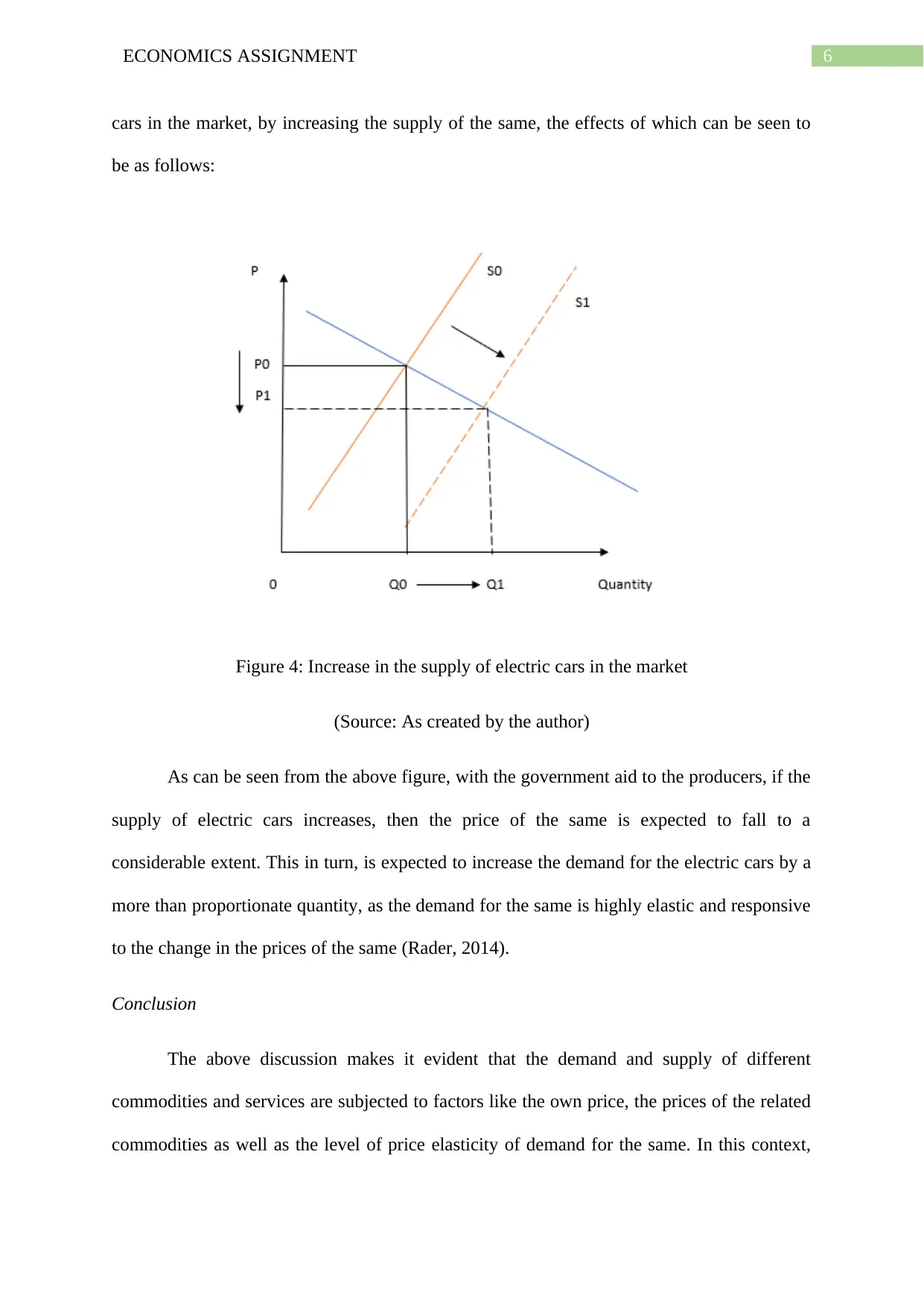
6ECONOMICS ASSIGNMENT
cars in the market, by increasing the supply of the same, the effects of which can be seen to
be as follows:
Figure 4: Increase in the supply of electric cars in the market
(Source: As created by the author)
As can be seen from the above figure, with the government aid to the producers, if the
supply of electric cars increases, then the price of the same is expected to fall to a
considerable extent. This in turn, is expected to increase the demand for the electric cars by a
more than proportionate quantity, as the demand for the same is highly elastic and responsive
to the change in the prices of the same (Rader, 2014).
Conclusion
The above discussion makes it evident that the demand and supply of different
commodities and services are subjected to factors like the own price, the prices of the related
commodities as well as the level of price elasticity of demand for the same. In this context,
cars in the market, by increasing the supply of the same, the effects of which can be seen to
be as follows:
Figure 4: Increase in the supply of electric cars in the market
(Source: As created by the author)
As can be seen from the above figure, with the government aid to the producers, if the
supply of electric cars increases, then the price of the same is expected to fall to a
considerable extent. This in turn, is expected to increase the demand for the electric cars by a
more than proportionate quantity, as the demand for the same is highly elastic and responsive
to the change in the prices of the same (Rader, 2014).
Conclusion
The above discussion makes it evident that the demand and supply of different
commodities and services are subjected to factors like the own price, the prices of the related
commodities as well as the level of price elasticity of demand for the same. In this context,
Paraphrase This Document
Need a fresh take? Get an instant paraphrase of this document with our AI Paraphraser
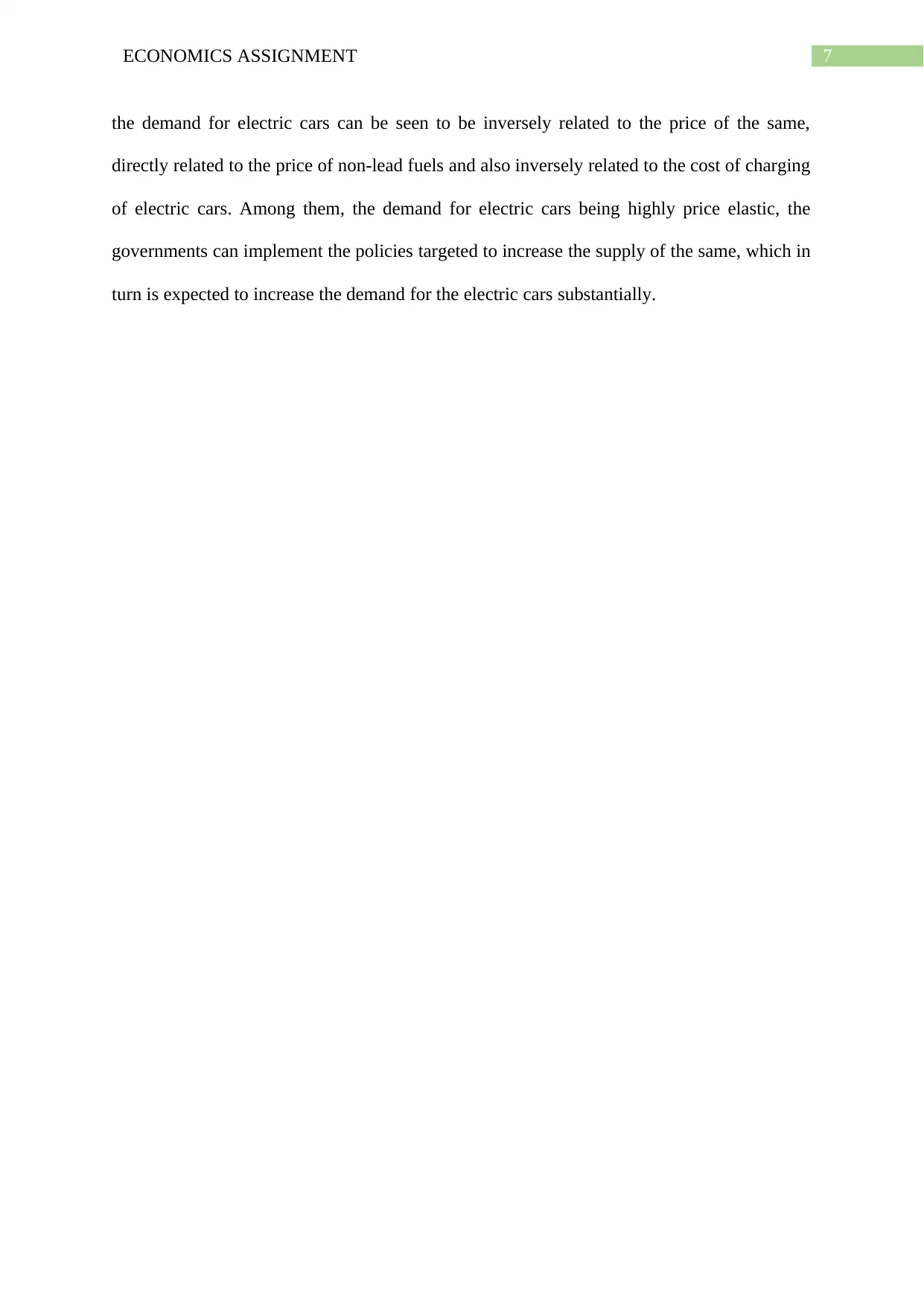
7ECONOMICS ASSIGNMENT
the demand for electric cars can be seen to be inversely related to the price of the same,
directly related to the price of non-lead fuels and also inversely related to the cost of charging
of electric cars. Among them, the demand for electric cars being highly price elastic, the
governments can implement the policies targeted to increase the supply of the same, which in
turn is expected to increase the demand for the electric cars substantially.
the demand for electric cars can be seen to be inversely related to the price of the same,
directly related to the price of non-lead fuels and also inversely related to the cost of charging
of electric cars. Among them, the demand for electric cars being highly price elastic, the
governments can implement the policies targeted to increase the supply of the same, which in
turn is expected to increase the demand for the electric cars substantially.
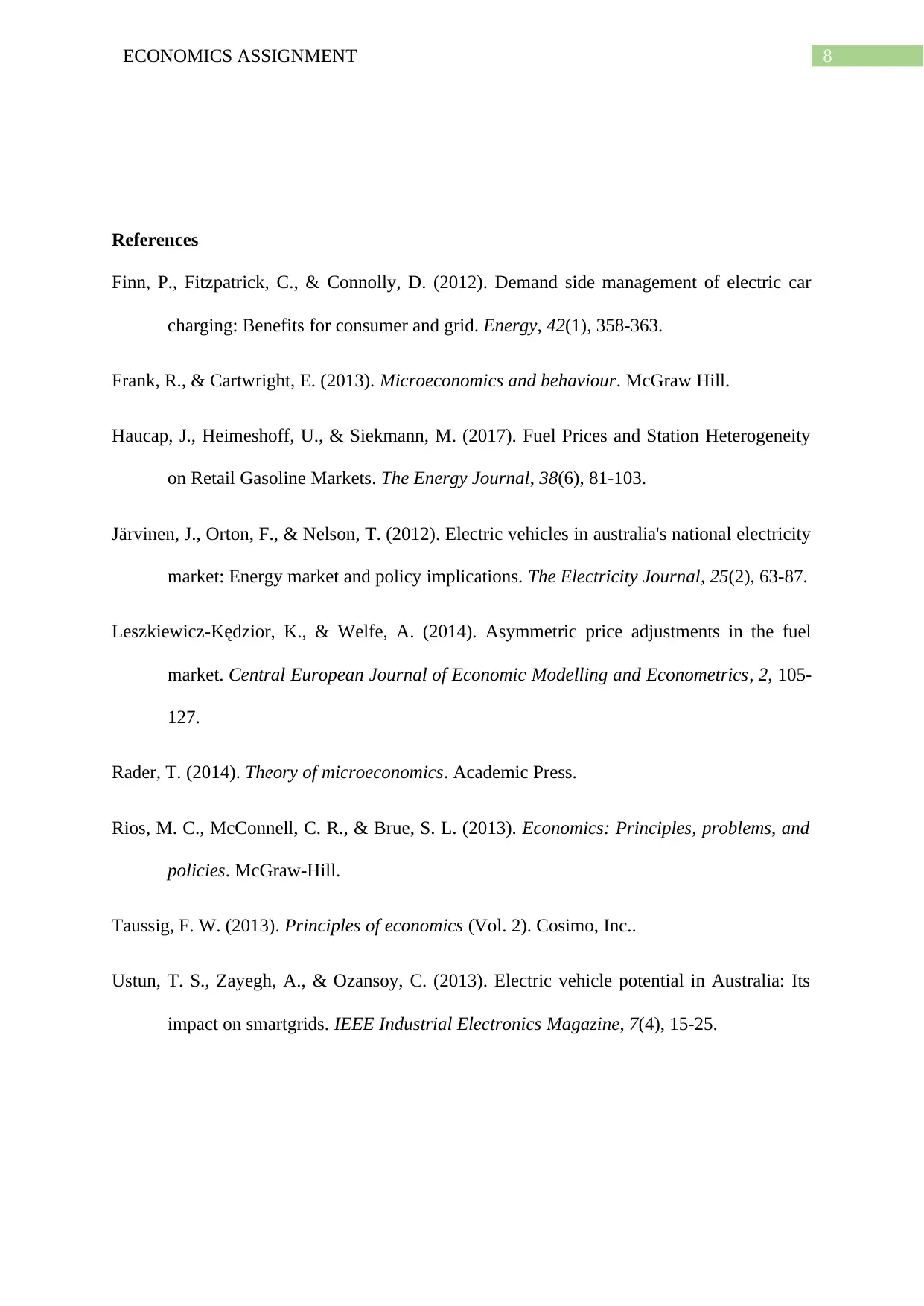
8ECONOMICS ASSIGNMENT
References
Finn, P., Fitzpatrick, C., & Connolly, D. (2012). Demand side management of electric car
charging: Benefits for consumer and grid. Energy, 42(1), 358-363.
Frank, R., & Cartwright, E. (2013). Microeconomics and behaviour. McGraw Hill.
Haucap, J., Heimeshoff, U., & Siekmann, M. (2017). Fuel Prices and Station Heterogeneity
on Retail Gasoline Markets. The Energy Journal, 38(6), 81-103.
Järvinen, J., Orton, F., & Nelson, T. (2012). Electric vehicles in australia's national electricity
market: Energy market and policy implications. The Electricity Journal, 25(2), 63-87.
Leszkiewicz-Kędzior, K., & Welfe, A. (2014). Asymmetric price adjustments in the fuel
market. Central European Journal of Economic Modelling and Econometrics, 2, 105-
127.
Rader, T. (2014). Theory of microeconomics. Academic Press.
Rios, M. C., McConnell, C. R., & Brue, S. L. (2013). Economics: Principles, problems, and
policies. McGraw-Hill.
Taussig, F. W. (2013). Principles of economics (Vol. 2). Cosimo, Inc..
Ustun, T. S., Zayegh, A., & Ozansoy, C. (2013). Electric vehicle potential in Australia: Its
impact on smartgrids. IEEE Industrial Electronics Magazine, 7(4), 15-25.
References
Finn, P., Fitzpatrick, C., & Connolly, D. (2012). Demand side management of electric car
charging: Benefits for consumer and grid. Energy, 42(1), 358-363.
Frank, R., & Cartwright, E. (2013). Microeconomics and behaviour. McGraw Hill.
Haucap, J., Heimeshoff, U., & Siekmann, M. (2017). Fuel Prices and Station Heterogeneity
on Retail Gasoline Markets. The Energy Journal, 38(6), 81-103.
Järvinen, J., Orton, F., & Nelson, T. (2012). Electric vehicles in australia's national electricity
market: Energy market and policy implications. The Electricity Journal, 25(2), 63-87.
Leszkiewicz-Kędzior, K., & Welfe, A. (2014). Asymmetric price adjustments in the fuel
market. Central European Journal of Economic Modelling and Econometrics, 2, 105-
127.
Rader, T. (2014). Theory of microeconomics. Academic Press.
Rios, M. C., McConnell, C. R., & Brue, S. L. (2013). Economics: Principles, problems, and
policies. McGraw-Hill.
Taussig, F. W. (2013). Principles of economics (Vol. 2). Cosimo, Inc..
Ustun, T. S., Zayegh, A., & Ozansoy, C. (2013). Electric vehicle potential in Australia: Its
impact on smartgrids. IEEE Industrial Electronics Magazine, 7(4), 15-25.
⊘ This is a preview!⊘
Do you want full access?
Subscribe today to unlock all pages.

Trusted by 1+ million students worldwide
1 out of 9
Related Documents
Your All-in-One AI-Powered Toolkit for Academic Success.
+13062052269
info@desklib.com
Available 24*7 on WhatsApp / Email
![[object Object]](/_next/static/media/star-bottom.7253800d.svg)
Unlock your academic potential
Copyright © 2020–2025 A2Z Services. All Rights Reserved. Developed and managed by ZUCOL.





